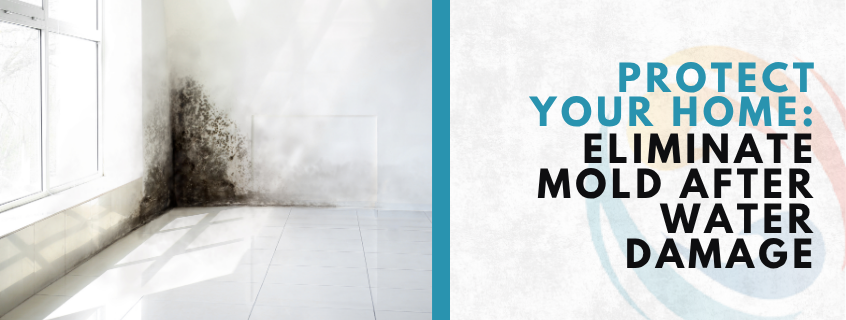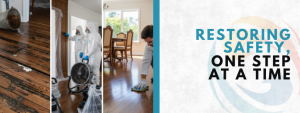When water seeps into your home, whether from a burst pipe, roof leak, or flooding, the visible damage isn’t your only concern. Within 24 to 72 hours, mold can begin to grow silently behind walls, beneath floors, or within ceilings. For homeowners in Calabasas, this issue is particularly relevant due to the area’s periodic humidity and occasional rainstorms. Understanding how to get rid of mold in house after water damage is essential to keep your living environment safe and your property protected.
Why Mold Appears After Water Damage
Mold is a natural organism that thrives in damp, warm, and dark environments. After water damage, moisture can linger in hidden areas such as drywall, carpets, or insulation. When spores in the air find these damp conditions, they begin to multiply rapidly.
Even a small amount of water left untreated can cause significant problems. For instance, a minor plumbing leak under the sink or behind a wall can create an ideal breeding ground for mold after water damage. In homes throughout Calabasas, where indoor humidity can stay elevated, the potential for mold growth is even higher.
Common Types of Mold Found in Water-Damaged Homes
Not all molds are equal, some are merely unsightly, while others pose real health risks. Recognizing which type of mold you’re dealing with can help you take appropriate action.
Stachybotrys (Black Mold)
Perhaps the most infamous, Stachybotrys chartarum, or black mold, is known for its dark, slimy texture. It grows on cellulose-rich materials like drywall, cardboard, and wood. Black mold releases mycotoxins that can trigger allergies, respiratory problems, and fatigue. This type requires professional handling and full remediation through water damage restoration services.
Cladosporium
Cladosporium appears as dark green, brown, or black patches and thrives in cooler areas like HVAC systems or under carpets. While not as toxic as black mold, it can still irritate the eyes, skin, and respiratory system especially in sensitive individuals.
Aspergillus
A common indoor mold, Aspergillus is usually powdery and can vary in color. It spreads easily through air vents and duct systems, making cleanup difficult without professional help. People with asthma or weakened immune systems are particularly vulnerable to this type of mold exposure.
Alternaria
Often found outdoors, Alternaria can enter your home through open windows or floodwater. Once inside, it colonizes on wet surfaces such as window frames, tiles, and damp fabrics. It’s one of the first molds to appear after flooding, making it a frequent culprit in Calabasas homes affected by water damage.
Hidden Warning Signs of Mold Growth
Mold doesn’t always make itself visible right away. In many homes, it hides behind walls or under floors until it’s already widespread. Watch for these early signs:
- A persistent musty or earthy odor
- Walls or ceilings with discoloration or bubbling paint
- Cold-like symptoms that worsen indoors
- Visible fuzzy patches on walls, ceilings, or carpets
- Increased allergy or asthma flare-ups
If your Calabasas home has recently experienced leaks, even small ones, take these symptoms seriously. Early intervention can save you thousands in repairs and safeguard your indoor air quality.
The Water Damage Mold Cleanup Process
Removing mold effectively involves more than just scrubbing it away. Professionals follow a detailed water damage mold cleanup process to ensure safety and long-term results.
Step 1: Inspection and Moisture Detection
Experts start by assessing the affected area using moisture meters and infrared cameras to locate hidden damp spots. Identifying the full scope of the water intrusion helps determine where mold is likely to grow.
Step 2: Containment
To prevent spores from spreading, technicians seal off the affected areas with plastic sheeting and use air scrubbers equipped with HEPA filters. This step is crucial in maintaining air quality throughout your Calabasas home.
Step 3: Mold Removal and Cleaning
Depending on the surface, remediation may involve scrubbing with antimicrobial cleaners, removing damaged materials, or applying biocides. For porous materials like drywall or carpet, removal is often necessary to eliminate contamination completely.
Step 4: Drying and Dehumidification
Even after cleaning, residual moisture can trigger regrowth. Industrial fans and dehumidifiers are used to dry out the structure thoroughly. This step is essential in learning how to get rid of mold in the house effectively and permanently.
Step 5: Restoration
Finally, any materials removed—such as drywall, flooring, or insulation—are replaced. The area is then tested to ensure mold levels have returned to normal before restoration is complete.
How to Get Rid of Mold in House: Why Professional Help Matters
Attempting to clean mold yourself can make the problem worse. Wiping visible patches may scatter spores into the air, causing them to spread to new areas. Professional Water Damage Restoration Calabasas uses specialized tools, filtration systems, and safe disposal methods to ensure a thorough cleanup.
These experts not only remove mold but also identify the root cause of moisture buildup, helping prevent future infestations. Searching online for water damage cleanup near me can connect you with local professionals equipped to handle even severe cases efficiently.
How to Prevent Mold Growth in the Future
Prevention is the best strategy for avoiding costly repairs and health issues. Here are practical steps to protect your home:
- Control indoor humidity: Keep levels below 50% using dehumidifiers or air conditioners.
- Fix leaks immediately: Even minor drips under sinks or around windows can create mold-friendly conditions.
- Improve ventilation: Use exhaust fans in bathrooms, kitchens, and laundry areas to reduce moisture buildup.
- Clean and dry quickly: After any spill or minor flooding, dry the area completely within 24–48 hours.
- Inspect regularly: Especially in Calabasas, where humidity fluctuates, routine home checks can help catch issues early.
Knowing how to get rid of mold in the house begins with prevention. Keeping your home dry and well-ventilated will go a long way toward maintaining a mold-free environment.
Protect Your Home Before It’s Too Late
Mold can turn a minor water incident into a major household hazard. Understanding how to get rid of mold in house after water damage is vital for your safety, comfort, and long-term property value. Whether it’s black mold on drywall or musty odors from the basement, quick and professional action is key.If you suspect hidden mold growth, don’t wait—search for water damage cleanup near me and connect with local specialists in Calabasas. They’ll help restore your home, eliminate health risks, and prevent mold from coming back.







